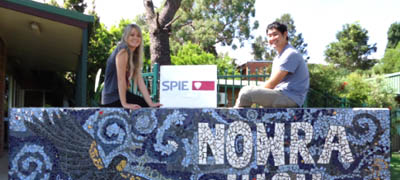
Sydney University PhD students Stephanie Crawford and Tomonori Hu brought optics lessons via interactive demontrations to remote schools in Australia, in a project funded by an SPIE grant.
Two students from the Sydney University SPIE Student Chapter spent five days travelling throughout rural Australia in March for a public outreach initiative dubbed "Optics in the Outback 2013." The program, funded by an SPIE Education Outreach grant, aims to provide rural school students with a basic yet engaging introduction to optics through interactive demonstrations otherwise not accessible to them.
Following the widespread success of the program in 2011, a much more intensive schedule was followed for the 2013 incarnation and carried out by PhD students Stephanie Crawford and Tomonori Hu. Both are at the university's Centre for Ultrahigh Bandwidth Devices for Optical Systems (CUDOS).
They visited two schools per day for four straight days, starting with a morning session with 50 senior science students at Nowra High School in New South Wales and then travelling throughout southern New South Wales in a great 1000km clockwise loop. Other stops included Ulladulla, Bateman's Bay, Narooma, Bega, Eden, Yass, and Young before their final stop at Orange High School.
Over the week, the program reached more than 350 students in 12 separate groups of students who ranged in age from 12 to 17.
At each school, Crawford and Hu gave topical presentations on recent scientific advancements such as:
- Crazy Lasers: How Do They Work and What Do We Do With Them?
- Harry Potter and the Metamaterial Invisibility Cloak
- Optical Communications: How Light Powers the Internet?
Their presentations were coupled with large-scale interactive demonstrations, made possible with the aid of students from University of Macquarie. The demonstrations included a laser maze and a laser telephone to emphasize the use of light for communicating information.
The pair left packages of educational optics kits as gifts to aid the teachers who enthusiastically indicated interest in having the program return in the future for the next group of students to enjoy the educational show.
The outstanding success of the program was summarized in the words of one student, "This has totally changed what I want to be when I grow up, everything. Forget about it; I want to be a physicist!"